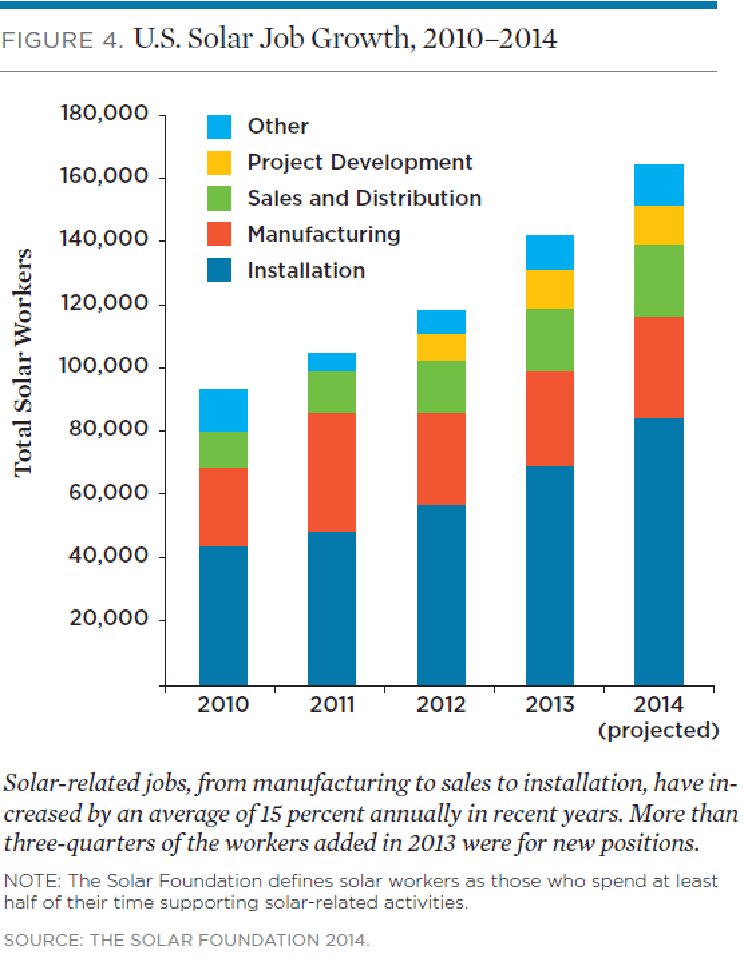
Supportive market-driven policy mechanisms and government R&D funding have been seminal in the creation of what's turned into a booming U.S. solar energy sector. Whether it's at the utility-, commercial- or residential-scale, using photovoltaics (PV) to produce renewable energy from sunlight is now financially viable wherever you live the U.S., according to a new study from the Union of Concerned Scientists (UCS).
Past and present performance is no guarantee of future success, however. The looming 2016 expiration of a key federal tax incentive – the solar investment tax credit – along with sharp cutbacks in leading European solar energy markets, international trade disputes and the imposition of punitive tariffs, have prompted U.S. solar industry participants to reassess their business plans. And while rapid growth and industry downsizing have brought PV cell and module supply and demand into balance – leading some PV manufacturers to even add capacity – profit margins, and the margin for error, are generally razor-thin.
In Solar Power on the Rise: The Technologies and Policies behind a Booming Energy Sector, UCS' Climate and Energy Program senior analysts John Rogers and Laura Wisland highlight the social, environmental and economic benefits of solar power: “The major drivers of the rapid adoption of solar power,” whether it be solar PV or concentrating solar power (CSP) technology. They then move on on to summarize “key steps to sustain the strong growth of solar power in the United States and its contribution to a more resilient electricity system in the decades ahead.”
U.S. solar energy boom's triple bottom line returns
Vital and growing solar power businesses and markets are providing triple bottom line benefits across the U.S., led by a small, but growing, number of states that have managed to assemble an institutional framework that supports and promotes renewable energy development and growth.
Over 480,000 solar energy systems with total generation capacity of 13,400 megawatts (MW) – enough to supply some 2.4 million U.S. homes – had been installed across the U.S. as of early this year. Between 2010 and 2013, U.S. solar energy installations increased by 485 percent, Rogers and Wisland highlight.
Socially, the boom in the U.S. solar energy sector has translated into over 140,000 green jobs as of 2013, a 53 percent increase since 2010. Growth of U.S. solar energy has progressed to the point where there are now more than 6,000 solar businesses spread across all 50 U.S. states and territories.
Environmentally, solar PV systems are proving to be an excellent means of avoiding the greenhouse gas emissions associated with fossil fuel use that are driving climate warming. Besides producing electricity with no carbon pollution, solid or liquid waste, solar PV systems – unlike coal, nuclear and natural gas-fired power plants – don't use up precious freshwater resources.
Economically, solar energy costs have declined to the point where they are competitive, or lower, than conventional alternatives. Furthermore, nearly $15 billion a year is being invested in solar energy in the U.S., Rogers and Wisland highlight.
Key steps to support ongoing rapid growth
In addition to reviewing the solar energy technologies in use today and the industry's development, Rogers and Wisland focus in on seven steps they assert are pivotal in ensuring that the rapid growth of solar energy in the U.S. continues:
- Renewable electricity standards: States should maintain and strengthen their key policies for driving renewable energy investments, including solar;
- Solar tax credit: The federal investment tax credit that has been so important for solar’s rise is set to decline at the end of 2016 from 30 percent to 10 percent; Congress will need to take action to sustain that support;
- Federal power plant carbon standards: States should ensure that solar plays a strong role in their plans to reduce emissions to comply with the Environmental Protection Agency’s new carbon standards;
- The full value of solar: Assessing the full range of benefits and costs of solar, particularly rooftop solar, will help policy makers decide the most appropriate way to assist more people in adopting it;
- Storage: Lower costs and the greater availability of energy storage technologies will help provide electricity more consistently and at times of peak demand;
- New utility business models: Utilities should modify their business models to accommodate high levels of rooftop solar and encourage continued solar development, from rooftops to large-scale projects;
- Research and development: Solar’s prospects will be enhanced by continued progress in reducing costs — through greater economies of scale, increasing cell and module efficiencies, improved inverters and mounting systems, better heat transfer, and streamlined transactions.
Rogers and Wisland's entire report is available free for download from the UCS website.
*All images credit: “Solar Power on the Rise: The Technologies and Policies behind a Booming Energy Sector,” Rogers and Wisland, Union of Concerned Scientists

An experienced, independent journalist, editor and researcher, Andrew has crisscrossed the globe while reporting on sustainability, corporate social responsibility, social and environmental entrepreneurship, renewable energy, energy efficiency and clean technology. He studied geology at CU, Boulder, has an MBA in finance from Pace University, and completed a certificate program in international governance for biodiversity at UN University in Japan.














